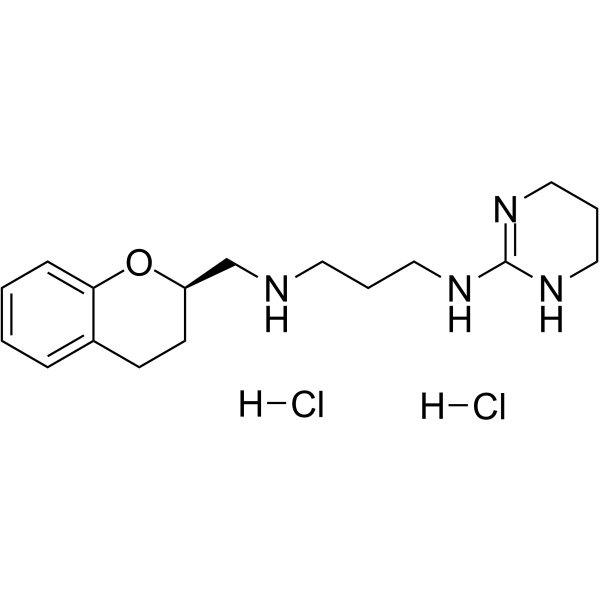Alniditan dihydrochloride
Modify Date: 2025-08-25 15:53:22

Alniditan dihydrochloride structure
|
Common Name | Alniditan dihydrochloride | ||
|---|---|---|---|---|
| CAS Number | 155428-00-5 | Molecular Weight | 375.34 | |
| Density | N/A | Boiling Point | N/A | |
| Molecular Formula | C17H28Cl2N4O | Melting Point | N/A | |
| MSDS | N/A | Flash Point | N/A | |
Use of Alniditan dihydrochlorideAlniditan (Alnitidan) dihydrochloride is a potent 5-HT1B and 5-HT1D receptors agonist, with IC50s of 1.7 nM and 1.3 nM for h5-HT1B and h5-HT1D receptors in HEK 293 cells, respectively. Alniditan dihydrochloride has migraine-preventive effects[1][2]. |
| Name | Alniditan dihydrochloride |
|---|
| Description | Alniditan (Alnitidan) dihydrochloride is a potent 5-HT1B and 5-HT1D receptors agonist, with IC50s of 1.7 nM and 1.3 nM for h5-HT1B and h5-HT1D receptors in HEK 293 cells, respectively. Alniditan dihydrochloride has migraine-preventive effects[1][2]. |
|---|---|
| Related Catalog | |
| Target |
human 5-HT1B Receptor:1.7 nM (IC50) human 5-HT1D Receptor:1.3 nM (IC50) 5-HT1B Receptor:0.9 nM (Kd) 5-HT1D Receptor:1.2 nM (Kd) |
| In Vitro | In vitro, Alniditan exhibits little vasoconstrictive effects on the rat basilar artery, although at a very high concentration 1 mM, Alniditan causes intensive constriction, most likely through a mechanism independent from 5-HT receptor activation[1]. |
| In Vivo | The intraperitoneal administration of Alniditan ED50=9 μg/kg dose dependly reduces [125I]-BSA extravasation in the rat meninges when done 30 min before stimulation. Alniditan dose dependently attenuateds the neurogenic inflammation in vivo model of neurogenic inflammation[1]. |
| References |
| Molecular Formula | C17H28Cl2N4O |
|---|---|
| Molecular Weight | 375.34 |
| InChIKey | GDNITZYKOOTAFK-QCUBGVIVSA-N |
| SMILES | Cl.Cl.c1ccc2c(c1)CCC(CNCCCNC1=NCCCN1)O2 |